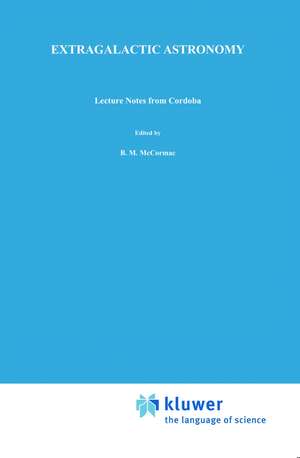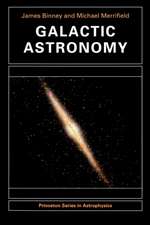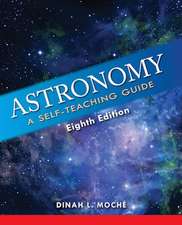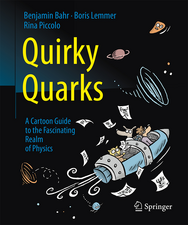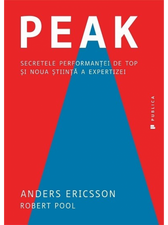Extragalactic Astronomy: Lecture notes from Córdoba: Geophysics and Astrophysics Monographs, cartea 20
Autor J.L. Sérsicen Limba Engleză Paperback – 3 noi 2011
| Toate formatele și edițiile | Preț | Express |
|---|---|---|
| Paperback (1) | 1215.53 lei 6-8 săpt. | |
| SPRINGER NETHERLANDS – 3 noi 2011 | 1215.53 lei 6-8 săpt. | |
| Hardback (1) | 1222.01 lei 6-8 săpt. | |
| SPRINGER NETHERLANDS – 31 mai 1982 | 1222.01 lei 6-8 săpt. |
Din seria Geophysics and Astrophysics Monographs
- 15%
 Preț: 646.43 lei
Preț: 646.43 lei - 24%
 Preț: 1032.02 lei
Preț: 1032.02 lei -
 Preț: 382.75 lei
Preț: 382.75 lei - 18%
 Preț: 950.33 lei
Preț: 950.33 lei - 15%
 Preț: 642.36 lei
Preț: 642.36 lei - 15%
 Preț: 641.53 lei
Preț: 641.53 lei - 18%
 Preț: 953.35 lei
Preț: 953.35 lei -
 Preț: 403.91 lei
Preț: 403.91 lei - 15%
 Preț: 641.71 lei
Preț: 641.71 lei -
 Preț: 402.17 lei
Preț: 402.17 lei - 15%
 Preț: 641.85 lei
Preț: 641.85 lei - 18%
 Preț: 1222.01 lei
Preț: 1222.01 lei - 18%
 Preț: 1825.44 lei
Preț: 1825.44 lei - 18%
 Preț: 2098.19 lei
Preț: 2098.19 lei - 18%
 Preț: 947.85 lei
Preț: 947.85 lei - 24%
 Preț: 794.98 lei
Preț: 794.98 lei - 18%
 Preț: 1227.52 lei
Preț: 1227.52 lei - 15%
 Preț: 641.03 lei
Preț: 641.03 lei -
 Preț: 384.48 lei
Preț: 384.48 lei - 15%
 Preț: 697.15 lei
Preț: 697.15 lei - 18%
 Preț: 2089.50 lei
Preț: 2089.50 lei - 18%
 Preț: 1232.57 lei
Preț: 1232.57 lei -
 Preț: 390.63 lei
Preț: 390.63 lei - 18%
 Preț: 943.73 lei
Preț: 943.73 lei - 18%
 Preț: 950.66 lei
Preț: 950.66 lei -
 Preț: 386.61 lei
Preț: 386.61 lei -
 Preț: 395.25 lei
Preț: 395.25 lei - 18%
 Preț: 951.91 lei
Preț: 951.91 lei
Preț: 1215.53 lei
Preț vechi: 1482.36 lei
-18% Nou
Puncte Express: 1823
Preț estimativ în valută:
232.60€ • 248.72$ • 193.93£
232.60€ • 248.72$ • 193.93£
Carte tipărită la comandă
Livrare economică 17 aprilie-01 mai
Preluare comenzi: 021 569.72.76
Specificații
ISBN-13: 9789400977280
ISBN-10: 940097728X
Pagini: 268
Ilustrații: XIII, 247 p.
Dimensiuni: 155 x 235 x 14 mm
Greutate: 0.38 kg
Ediția:Softcover reprint of the original 1st ed. 1982
Editura: SPRINGER NETHERLANDS
Colecția Springer
Seria Geophysics and Astrophysics Monographs
Locul publicării:Dordrecht, Netherlands
ISBN-10: 940097728X
Pagini: 268
Ilustrații: XIII, 247 p.
Dimensiuni: 155 x 235 x 14 mm
Greutate: 0.38 kg
Ediția:Softcover reprint of the original 1st ed. 1982
Editura: SPRINGER NETHERLANDS
Colecția Springer
Seria Geophysics and Astrophysics Monographs
Locul publicării:Dordrecht, Netherlands
Public țintă
ResearchCuprins
I: Forms and Structures.- 1.1. Normal and Peculiar Galaxies.- 1.2. Classification of Normal Galaxies.- 1.3. Apparent and True Flattening of Galaxies.- 1.4. Other Classifications Systems.- 1.5. Classification of Peculiar Galaxies.- II: Normal Galaxies.- II.1. Contents.- II.1.1. Photometric Properties.- II.1.2. Stellar Content.- II.1.3. The Interstellar Medium in Galaxies.- II.1.4. Subsystems.- II.2. Motions and Masses.- II.2.1. Kinematics.- II.2.2. Masses of Galaxies.- II.2.3. Mass-Luminosity Ratios.- II.3.2. Evolution of Galactic Content.- III: Active Galaxies.- III.1. Classification.- III.2. Intergalactic H II Regions (IG H II).- III.3. Galaxies with Nuclear Emission (neG).- III.4. Irr II Galaxies.- III.5. Seyfert Galaxies (SyG).- III.5.1. Spectrum of Emission.- III.5.2. Continuum Spectrum.- III.5.3. Variability.- III.5.4. Radioemission.- III.5.5. Correlations.- III.6. Strong Radio Galaxies (SRG).- III.6.1. Radio Structures.- III.6.2. Spectrum of Radio Frequencies.- III.6.3. Time Scale.- III.6.4. Compact Sources.- III.6.5. Optical Forms Associated with SRG’s.- III.6.6. Optical Spectra.- III.6.7. Energetics of SRG’s.- III.7. N Galaxies.- III.8. Quasi Stellar Objects (QSO).- III.8.1. Continuum Spectrum.- III.8.2. Line Spectrum.- III.8.3. BL Lacertae Objects.- III.8.4. Redshifts and Nature of the QSO’s.- III.9. Activity in Compact Objects.- III.9.1. Excitation Mechanism.- III.9.2. The Source of Energy.- IV: Galaxies and their Environment.- IV.1. Tidal Interactions.- IV.1.2. Non-tidal Interactions.- IV.2. Agregates of Galaxies.- IV.2.1. Pairs and Multiplets.- IV.2.2. Groups of Galaxies.- IV.2.3. Clusters.- IV.2.4. Second Order Clustering.- IV.2.5. Clustering.- IV.3. Mean Mass Density of Matter in the Universe.- V: Measuring the Universe.- V.1. Distance Indicators.-V.1.1. Primary Distance Indicators.- V.1.2. Other Photometric Indicators.- V.1.3. Geometric Indicators.- V.1.4. Other Indicators.- V.2. The Scale of Distances.- V.2.1. The Hubble Flow.- V.2.2. The Quest for H0.- V.3. Far Away and Long Ago.- V.3.1. TheRedshift.- V.3.2. The Hubble Law.- VI: Cosmology.- VI.1. Basic Assumptions.- VI.2. Explosive Cosmologies.- VI.3. Thermal Evolution of the Universe.- VI.4. Primaeval Nucleosynthesis.- VI.5. The Background Radiation.- VI.6. Observational Cosmology.- VI.6.1. Observable Parameters.- VI.6.2. Fitting the Model to the Universe.- VI.6.3. Lifting the Restriction ? = 0.- VII: Gravitational Instability and Galaxy Formation.- VII.1. Theory of Jeans’ Wavelength and Mass.- VII.1.1. The Jeans Mass.- VII.2. Gravitational Instability in an Expanding Universe.- VII.2.1. The Era of Gravitational Instability.- VII.3. Protogalaxies.- VII.3.1. Non-linear Growth of a Density Perturbation.- VII.4. Galaxy Formation Through Dissipative Collapse.- VII.4.1. Stationary State out of Equilibrium.- VII.4.2. Hierarchy of Fragmentations.- VII.4.3. The End of the Hierarchy.- VII.4.4. Global Dynamics.- VII.4.5. The Influence of Rotation.- VI.5. Dissipationless Collapse.- VIII: Notes and Comments.- VII.1. Catalogs and Atlas of Galaxies.- VIII.2. Composite Spectra.- VIII.3. The H I Spectrum.- VIII.4. Determination of Rotation Curves.- VIII.5. Rotation Period of Central Regions in Galaxies.- VIII.6. Note for Section V.1.3.
